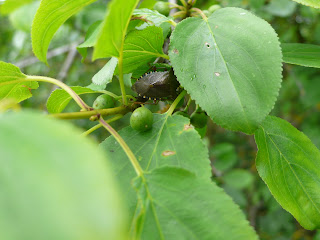Persian Berries
Today I've enjoyed the glorious British summertime with some berry collecting.
The unripe fruit of Rhamnus cathartica, otherwise known as Buckthorn or Persian Berries, produces a beautiful yellow dye at this time of year. The shrub is less and less common in hedgerows, where farmers and councils plant more common plants such as blackthorn or hawthorne. This decrease in biodiversity is not only a problem for British wildlife (Brimstone butterflies and field mice, to name but a few) but also for local bookbinders!
Medieval alum-tawed bindings were commonly dyed with cheap local organic colours such as madder and buckthorn, and whilst much evidence of this practice has been lost, tell-tale signs can still be found on turn-ins protected from light damage or the inside of a chemise.
When rebinding for conservation, using traditional natural dyes can be a viable choice; these colours are well known, and whilst they will fade over time, they will also protect a regularly handled binding from some of the wear, tear, and surface dirt which shows so quickly on an undyed creamy white alum-tawed skin. I like the connection to historical binding techniques that these dyes provide, the talking point, and their surprisingly complementary tones when seen next to aged paper or parchment.







Comments
Post a Comment